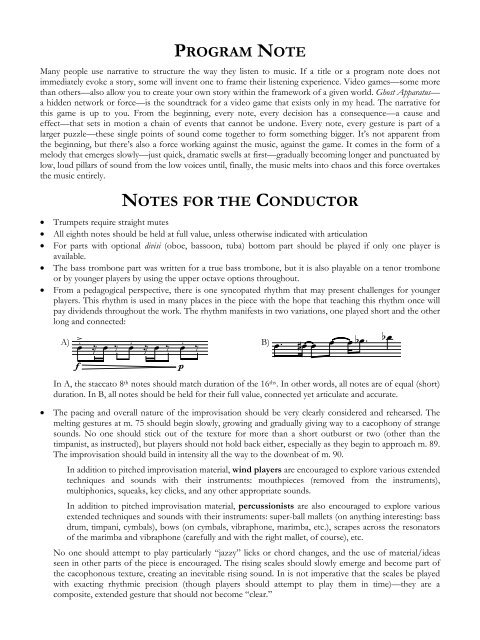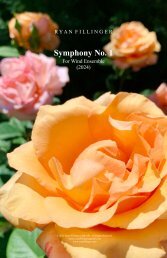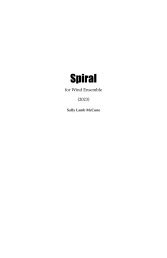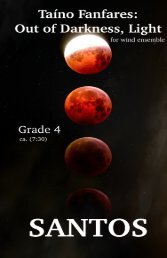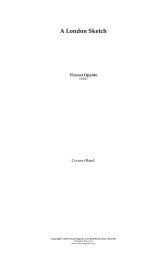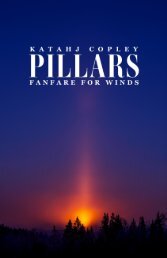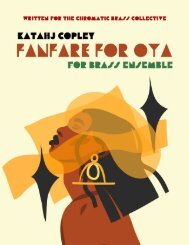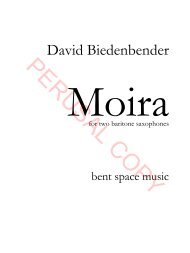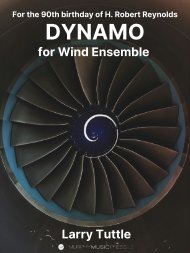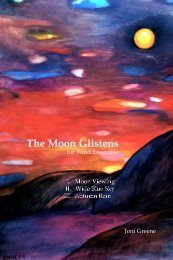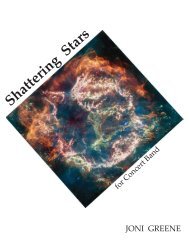Ghost Apparatus - Full Score
You also want an ePaper? Increase the reach of your titles
YUMPU automatically turns print PDFs into web optimized ePapers that Google loves.
∑<br />
‰<br />
B. Cl. ¢ &<br />
.<br />
bœ<br />
œ ˙ œ # œ. œ œ œ.<br />
œ bœ<br />
œ<br />
f<br />
# œ œ<br />
œ ‰ œ ‰ ‰ œ ff<br />
Œ œ ‰ œ<br />
1<br />
°<br />
Ÿ~~~~~~~~~~~~~~~~~~~~~~~~~~<br />
‰ œ<br />
A. Sax. & Ó<br />
><br />
œ Œ ‰ œ ‰ œ<br />
2<br />
# ˙ œ Œ bœ<br />
# ˙<br />
œ œ<br />
PROGRAM<br />
f<br />
NOTE<br />
div.<br />
a2<br />
Œ ‰ Many people ‰ use narrative Œ to ‰ structure<br />
œ<br />
T. Sax.<br />
bœ&<br />
œb bœ ‰ the way they<br />
œ<br />
‰ listen Œto music. If a title ‰ or a program ‰ note does not<br />
immediately evoke a story, some will invent one bœto frame their listening experience.<br />
#œ<br />
# œ nœ<br />
bœ<br />
# œ œ œ Video œœ<br />
œgames—some bœ<br />
more œ<br />
than others—also allow you to create your own story # œ œ<br />
f within the framework of a given world. <strong>Ghost</strong> <strong>Apparatus</strong>—<br />
œ ff<br />
‰ œ a hidden network ‰ ‰ œ or force—is<br />
Œ œ the soundtrack<br />
‰ œ for a video ‰ > œ game that exists only<br />
B. Sax. ¢ & nœ<br />
bœ<br />
œ œ # œ œ # œ œ bœ<br />
œ Œ ‰ œ in my head.<br />
‰ œThe narrative for<br />
this game is up to you. From the beginning, every note, every decision has a consequence—a cause and<br />
œ # œ œ<br />
effect—that sets in motion a chain of events that cannot be undone. Every note, every gesture is part of a<br />
bœ<br />
f mp<br />
larger puzzle—these single points 2,3 of sound come together 2,3 to form ff something bigger. It’s not apparent from<br />
‰<br />
°<br />
œ ‰ the beginning, Œ but there’s ‰ also ‰ a force<br />
Tpt. œ 1 & bœ bœ<br />
‰ working against<br />
˙ b œ<br />
b˙<br />
œ<br />
‰ the music, against ‰ ‰ the game. It ‰ comes in the form of a<br />
melody that emerges slowly—just quick, dramatic Œ<br />
bœ<br />
# ˙<br />
œ œ<br />
><br />
œœ swells at first—gradually bœ becoming œ longer and œ punctuated by<br />
low, loud pillars of sound from the low voices until, finally, the music melts into chaos and this force overtakes<br />
f<br />
mp<br />
the music entirely.<br />
ff<br />
Tpt.<br />
2 ‰ Œ ‰ ‰<br />
& ˙ b ‰ Œ<br />
˙˙<br />
Œ ‰ ‰<br />
3œ<br />
bœ œ œ bœ<br />
# ˙œ<br />
œ<br />
œ NOTES FOR<br />
ff<br />
> œ THE CONDUCTOR bœ œ<br />
mp<br />
1.> . . f<br />
#<br />
¢ & ˙ ˙˙ Œ # œ ˙ œ<br />
b œ ≈ œ ‰<br />
œ ≈ œ ‰<br />
œ ‰<br />
∑<br />
• Trumpets require straight mutes<br />
• Hn. All eighth 2 notes should be held at full value, unless otherwise indicated with articulation<br />
• For parts with optional divisi (oboe, bassoon, tuba) bottom part should ff be played if only one player is<br />
available. f<br />
p<br />
bœ<br />
œ # œ nœ<br />
# œ œ œ bœ<br />
bœ<br />
• The bass trombone part was written ‰ for a true bass ‰ trombone, b œ ‰ but it ‰ is also œplayable Œ on a tenor trombone<br />
Tbn. or by younger bœ œ<br />
2<br />
players by using the upper octave<br />
><br />
œ options throughout.<br />
• From a pedagogical perspective, there is one f syncopated mprhythm ff that may present challenges for younger<br />
?<br />
B. Tbn.<br />
bœ<br />
b˙<br />
œ # œ œ œ œ bœ<br />
bœ<br />
players. This<br />
œ<br />
œ<br />
‰ rhythm Œ is used ‰ in many<br />
‰<br />
places in the<br />
bœ<br />
œ<br />
bœ<br />
><br />
œ ‰<br />
piece with<br />
Œ<br />
the hope that<br />
‰<br />
teaching this<br />
œ ‰<br />
rhythm once will<br />
pay dividends throughout the work. The rhythm manifests in two variations, one played short and the other<br />
bœ<br />
long and connected:<br />
‰ œ ‰ œ 1Œ ° ? b œbœ<br />
‰ ‰<br />
? bœ<br />
a2 b ˙ œ # œ œ œ œ bœ<br />
∑ > œ. ≈ œ ‰ œ. ≈ œ ‰ œ . ‰<br />
∑<br />
A) B)<br />
Euph.<br />
f<br />
? a2 -><br />
Tba. ¢ bœ<br />
b˙<br />
œ<br />
bœ<br />
œ ‰ Ó ‰ Œ Ó<br />
bœ<br />
Œ ‰ Œ Ó<br />
bœ<br />
œ<br />
. .<br />
pp f pp f<br />
ff<br />
1,2<br />
∑<br />
∑<br />
-><br />
? bœ<br />
b˙<br />
œ<br />
bœ<br />
w<br />
‰ Œ Ó<br />
∑<br />
Œ ‰<br />
Œ ‰<br />
œ<br />
• The pacing and overall nature of the improvisation should be very clearly considered and rehearsed. The<br />
melting gestures at m. 75 should begin slowly, growing and gradually giving way to a cacophony of strange<br />
sounds. No one should stick out of the texture for more than a short outburst or two (other than the<br />
D.B.<br />
p relaxed<br />
timpanist, as instructed), but players should not hold back either, especially as they begin to approach m. 89.<br />
1,2<br />
The improvisation should build in intensity all the way to the ff downbeat of m. 90.<br />
131<br />
∑<br />
p<br />
f<br />
In A, the staccato 8 th notes should match duration of the 16 ths . In other words, all notes are of equal (short)<br />
duration. In B, all notes should be held for their full value, connected yet articulate and accurate.<br />
Timp. multiphonics,<br />
? # squeaks, œ key bœ<br />
clicks, and # æ˙ any other appropriate sounds.<br />
Œ ‰ œ<br />
Œ Ó<br />
b œ ‰ Œ ‰ ‰<br />
bœ > œ b<br />
f fp ff ><br />
œ<br />
><br />
œ ‰ Œ b œ ‰ œ ‰<br />
In addition to pitched improvisation material, percussionists are also encouraged to explore various<br />
œ.<br />
. f<br />
extended techniques and sounds . . . . . .<br />
° œ.<br />
bœ with their instruments:<br />
œ.<br />
œ<br />
œ.<br />
bœ super-ball mallets<br />
.<br />
œ(on anything<br />
.<br />
.<br />
Vib. & ‰<br />
‰<br />
œ œ<br />
œ interesting: bass œ<br />
œ<br />
bœ<br />
drum, timpani, cymbals), bows (on cymbals,<br />
Œ ‰ œ b œ ‰ Œ Ó w vibraphone, marimba, etc.), scrapes across the resonators<br />
of the marimba and vibraphone (carefully and with the right mallet, of ‰ course), etc. Œ<br />
No one should attempt<br />
Mar. & > to play particularly<br />
p<br />
“jazzy”<br />
relaxed<br />
licks or<br />
b> chord changes,<br />
œ > and<br />
œ > the use of<br />
œ > material/ideas<br />
œ bbœ> œ œ><br />
seen in other parts of the piece is encouraged. The rising scales should slowly emerge and become part of<br />
Œ ‰ ‰ bbœœ<br />
Œ ≈‰<br />
œ ‰ œ<br />
‰ ≈œ ‰ œ<br />
the cacophonous texture, creating ‰ Œ<br />
‰ ‰<br />
œ<br />
bœ an inevitable œ rising sound. In is not imperative that the scales be played<br />
with bexacting œ rhythmic precision<br />
bœ<br />
(though<br />
œ bœplayers should attempt bœto play them<br />
> > > > > > > > > > > > ><br />
Perc. 1 / œ œ œ œ œ ><br />
œ in time)—they are a<br />
composite, extended gesture that should not<br />
œ œ œ œ fbecome œ œ œ “clear.”<br />
œ œ œ œ œ œ œ<br />
mpœ œ œ œ œ œ œ œ œ œ œ œ<br />
œ œ œ œ œ<br />
Œ ‰ bœ<br />
bœ<br />
Œ ‰<br />
bœ<br />
‰<br />
œ b<br />
><br />
œ Œ bœ<br />
œ<br />
f<br />
w<br />
In addition to pitched improvisation material, wind players are encouraged to explore various extended<br />
p relaxed<br />
techniques and sounds with their instruments: mouthpieces (removed from the instruments),<br />
ff<br />
ff<br />
mp<br />
mp<br />
bœ<br />
bœ<br />
bœ<br />
bœ<br />
œ<br />
œ<br />
# œ œ<br />
# œ œ<br />
# œ œ


